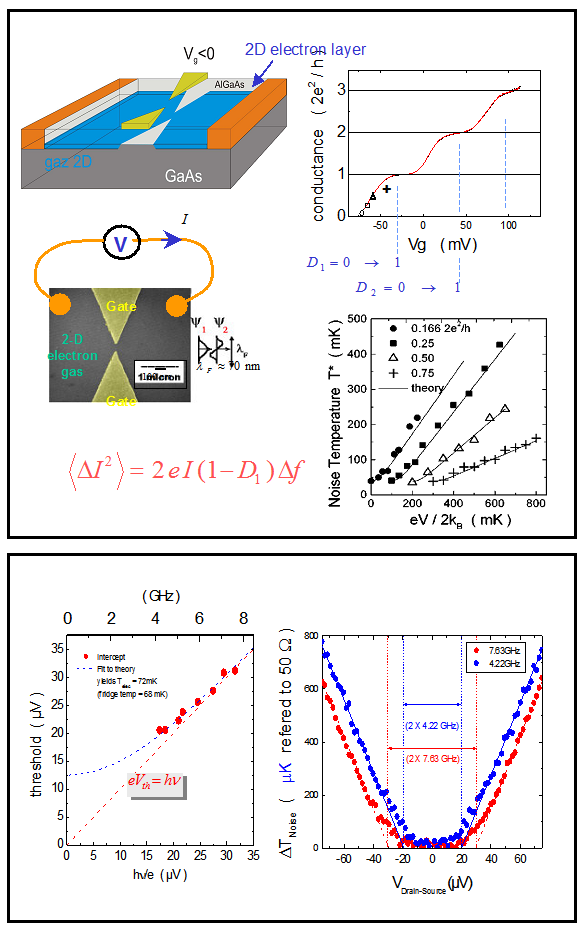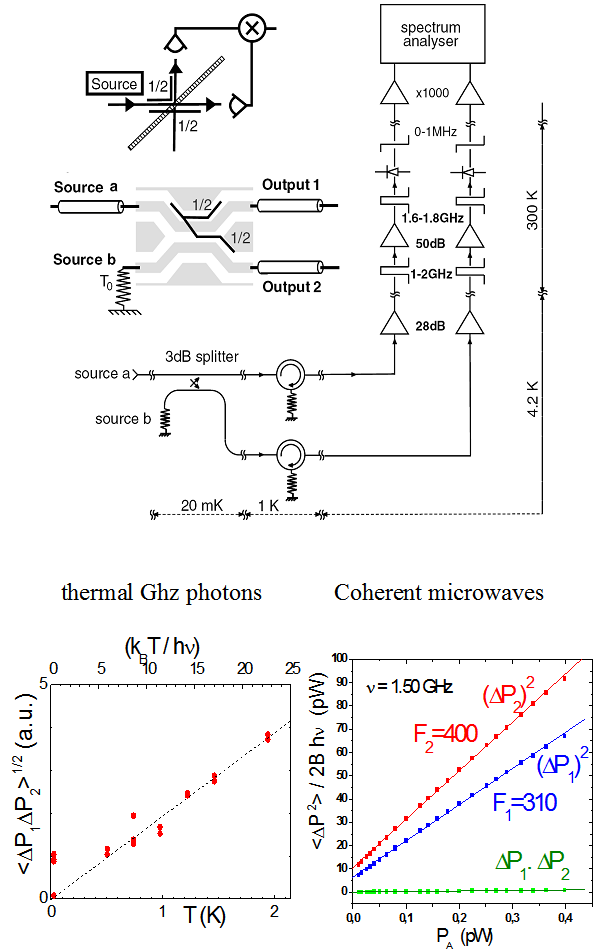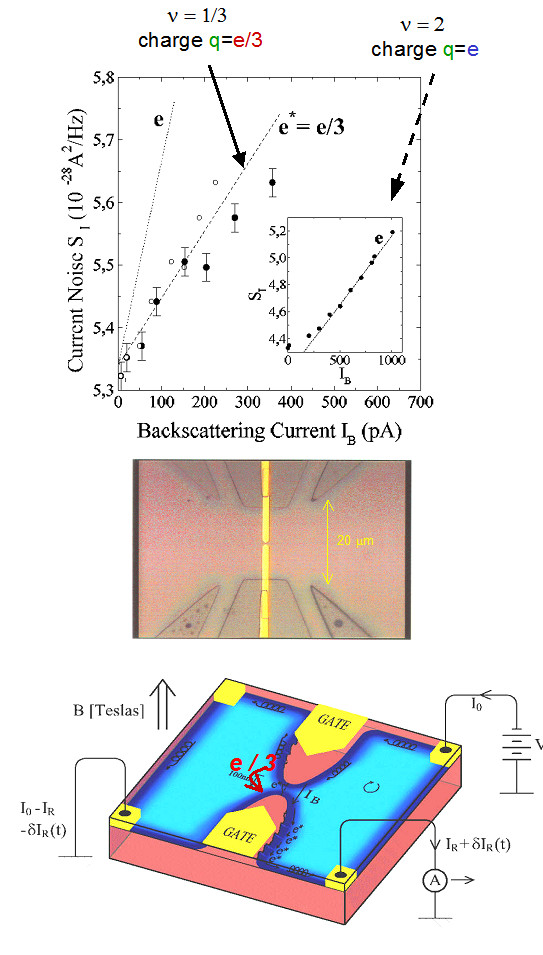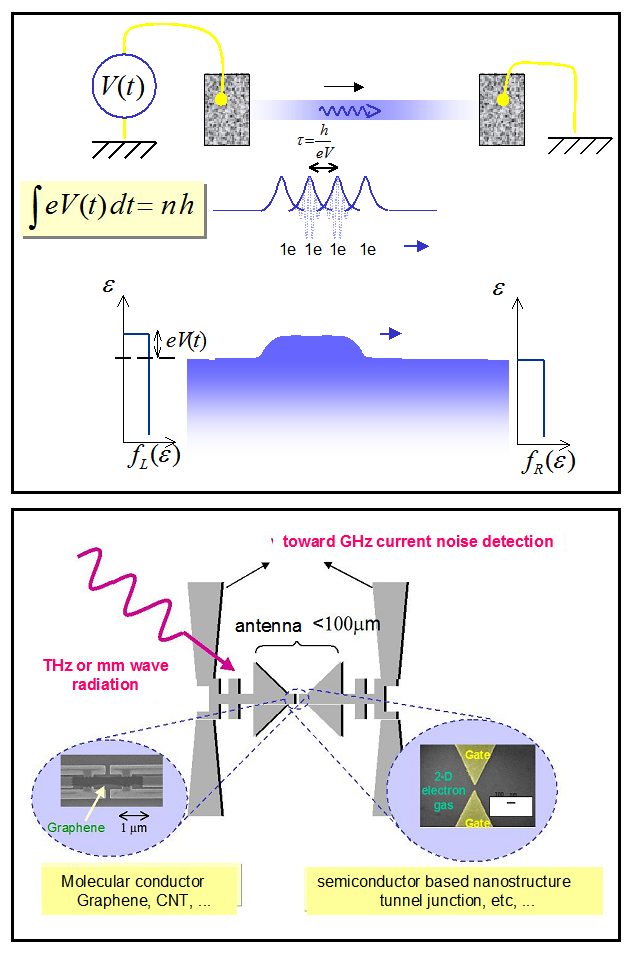Quantum Shot Noise, quantum coherence, Quantum Hall effects
Quantum Shot Noise: the silence of the electrons
- Absence of shot noise for perfectly transmitted electrons:
Fermi statistics (or Pauli exclusion) is responsible for the regular (noiseless) emission of electrons by a contact biased at potential V. Electrons are emitted at frequency eV/h in each mode able to propagate through the conductor. For perfectly transmitted electronic mode no current noise is observed while if the mode is partially transmitted, transmission/reflection of electrons occurs leading to current fluctuations. This quantum shot noise arise both from electron granularity and quantum uncertainty. The Nanoelectronics Group has been pionneer in developping noise correlation techniques in order to observe the full quantum shot noise suppression in a Quantum Point contact and provide quantitative comparison with quantum scattering models. ‘Experimental Test of the Quantum Shot Noise Reduction Theory’, A. Kumar, L. Saminadayar, D. C. Glattli, Y. Jin, and B. Etienne, Phys. Rev. Lett. 76, 2778-2781 (1996)
- Photo-assisted quantum shot noise:
Can one measure electron shot noise while no current flows through a conductor? We showed that the role of the bias voltage can be replaced by the photon energy quantum hn when the contact is irradiated by a microwave of amplitude Vac. An electron emitted by the contact may absorb a photon with probablity ~(eVac/2hn)2 and an electron-hole pair is created. Electrons and holes are separately transmitted/reflected through the conductor therfore generating current fluctuations or shot noise even though no dc current can be generated by the neutral e-h pairs. Using a Quantum Point Contact we provided direct quantitative measurements of photo-assisted e-h shot noise and its complete suppression when electronic mode are perfectly transmitted. Also, upon applying a dc bias voltage V, the competition between transport and photo-assisted noise leads to an observable singularity in the noise variation at dc voltage eV=hv. ‘Quantum Partition Noise of Photon-Created Electron-Hole Pairs’, L.-H. Reydellet, P. Roche, D. C. Glattli, B. Etienne, and Y. Jin, Phys. Rev. Lett. 90, 176803 (2003)
- Suppressed shot noise at the 0.7 structure of Quantum Point Contacts:
Interactions are known to introduce correlations between electrons which reduce noise as Fermi statistics do. Reduce noise can be provided by a reduced quasiparticle charge (see fractional quantum Hall effect below) or, in zero magnetic field, by lifting the spin degeneracy: for a given total transmission more channels (up/dow spin or singlet/triplet channels) will give less noise than a single degenerate channel. The 0.7 anomaly found in QPC is believed to result from a zero field spin splitting due to interactions. Combining both conductance and noise allowed us to unambiguously demonstrate that spin degenracy is actually lifted. ‘Fano Factor Reduction on the 0.7 Conductance Structure of a Ballistic One-Dimensional Wire’, P. Roche, J. Ségala, D. C. Glattli, J. T. Nicholls, M. Pepper, A. C. Graham, K. J. Thomas, M. Y. Simmons, and D. A. Ritchie,, Phys. Rev. Lett. 93, 116602 (2004)
- NEW suppression of quantum shot noise at high frequency n>eV/h
Extracting information of a quantum system at high frequency means exchanging at least an energy quantum hn between the system and the detector. When measuring high frequency current noise power, electromagnetic modes are excited in the external measuring circuit and the power flows from the noisy conductor to the quiet detector . This power is proportional to the current noise power and is carried by photons of finite energy. The energy range of electrons particpating in the shot noise radiated at frequency n is no longer eV but eV-hn. The noise thus simply decreases linearly with frequency and is totally suppressed when eV< hn electrons have no longer enough energy to emit photons. Developping new ultra-low noise techniques at GHz frequencies we have observed the eV=hn singularity for a Quantum Point Contact and provided full quantitative comparison with theory. ‘Experimental test of the high frequency shot noise theory in a Quantum Point Contact’, E. Zakka-Bajani, J. Ségala, F. Portier, P. Roche and D.C. Glattli, Phys. Rev. Lett. 99, 236803 (2007)
New noise project: Mesoscopic Quantum Noise. From few electron statistics to shot noise based photon detection.
ERC Advanced grant (2008 call) (see below)

Statistics of photons emitted by quantum conductors
Combining the quantum physics of electrons (Fermions) in mesoscopic conductors with that of photons (Bosons) is a new promising fields. A fundamental question is: what is nature of the photon field? what is the photon statistics? is it possible to generate non-classical photons, i.e. quiet photons with sub-Poissonian statistics? According to ’63 Glauber’s theory of radiation, a classical oscillating current is a source of electromagnetic field generating photons with Poissonian statistics. A collection of oscillating currents with no temporal phase relation is expected to generate e.m. fields with Gaussian amplitude distribution and finally to build a thermal like distribution for photons (but eventually having different effective temperature for different frequencies). In a recent work CW.J. Beenakker and H. Schomerus have adressed the statistics of photons emitted by a quantum conductor where the current operator is no longer to be considered as classical. This motivated the following works.
As typical electron energies for best observation of quantum effects are sub-Kelvin, the photons are in the GHz (microwave) range. The usual tools to characterize photons in optics are not available here. This led us to develop new original techniques to perform “QUANTUM OPTICS AT CELL PHONE FREQUENCY”
- A GHz Photon Hanbury-Brown Twiss (HBT) experiment:
How to characterize the statistics of photons. Since ’57 experiments by Hanbury Brown and Twiss, the best approach is to send the photon field to be analysed on a semi-transparent mirror at 45° and send the transmitted and reflected output toward two separate detectors which measure the mean photon fluxes and their fluctuations. In addition cross-correlation of the power fluctuations are done. We expect positive cross-correlation for a thermal field (black-body radiation with Bose-Einstein distribution) and zero cross-correlation for the case of a Poissonian photon statistcs as that provided by coherent sources (Laser in optics). A negative correlation signals a so-called non-classical photon field and a perfect negative cross-correlation a single photon source.
In a join work with the LPA ENS team (Mesoscopic Physics group) we designed a HBT experiment for microwave photons. A 3dB strip-line power splitter stands for the semi-transparent mirror and the detector are now cryogenic ultra-low noise amplifiers followed by room temperature quadratic detectors with fast response. We have measured the power detected and its fluctuation for transmitted and reflected pathes and have performed cross-correlation of the power fluctuations. This has allowed us to show that the statistics of a thermal field, generated by resistor with controlled temperature, can be discriminated from the statistics of a coherent field provided by a rf-GHz synthetizer. Measurements were done in the limit of few photon population ~1 to 100 with kT< or > hn. ‘Hanbury-Brown Twiss correlations to probe the population statistics of GHz photons emitted by conductors’, J. Gabelli, L.-H. Reydellet, G. Fève, J.-M. Berroir, B. Plaçais, P. Roche, and D.C. Glattli, Phys. Rev. Lett. 93, 056801 (2004)
- NEW Quantum statistics of photons emitted by a tunnel junction:
We investigate the simplest mesoscopic quantum conductor: a tunnel junction. The current fluctuations in the quantum shot noise regime are the source of the photons emitted in the external circuit and we provide the first measure of the statistics of these photons. Here the current can not be considered as classical as in Glauber’s approach but as quantum, particularly when eV~hn. Our measurements show that: 1) cross-correlation of the photon noise are positive, 2) cross-correlation are suppressed for eVn as, concurrently, photon emission is suppressed for voltage below frequency ( see above the high frequency noise in a QPC), 3) the photon statistics is black-body like. This can be explained as the concurrence of many photons emitted at the same time by the many electronic modes which participate to the tunnel conduction. ( E. Zakka Bajjani et al in preparation)
- Short term project: “Non-classical photons emitted by a Quantum Point Contact-QCP
We expect that, with only one electron mode partially transmitted, the high frequency current fluctuations generated by quantum shot noise will generate non-classical photons when eV is smaller but close to hn. In this regime, there will be no two or more photons emitted simultaneously when electrons cross the QPC and emission for a next photon will not take place before a finite time ( typically h/(eV-hn) ). The correlation time separating two photons is therefore typical of anti-bunching or non-classical statistics.

Electronic Mach-Zehnder Interferometer: from single electron Quantum Coherence toward statistical electron entanglement:
(under construction)
Noise Dephasing in Edge States of the Integer Quantum Hall Regime ,P. Roulleau, F. Portier, P. Roche, A. Cavanna, G. Faini, U. Gennser, and D. Mailly, Phys. Rev. Lett. 101, 186803 (2008) http://link.aip.org/link?prl/101/186803
Direct Measurement of the Coherence Length of Edge States in the Integer Quantum Hall Regime, Preden Roulleau, F. Portier, P. Roche, A. Cavanna, G. Faini, U. Gennser, and D. Mailly, Phys. Rev. Lett. 100, 126802 (2008) http://link.aip.org/link?prl/100/126802
Finite bias visibility of the electronic Mach-Zehnder interferometer, Preden Roulleau, F. Portier, D. C. Glattli, P. Roche, A. Cavanna, G. Faini, U. Gennser, and D. Mailly, Phys. Rev. B 76, 161309 (2007) http://link.aip.org/link?prb/76/161309

Quantum Hall Effect:
2D electrons in perpendicular magnetic field acquire unsual properties due to the quantization of the cyclotron motion and the formation of Landau levels. The high Landau level degeneracy (one quantum state per flux quantum in the plane for each LL) combined with Fermi statistics lead to a quantization of the Hall resistance B/en, each time the density n is an integer times the flux quantum density eB/h, leading to quantized Hall resistance plateaus at RHall =h/pe2 (p integer). The Nanoelectronics Group, either uses Quantum Hall effect as a convenient tool to perform mesoscopic physics, taking advantage of chiral 1D modes propagating along the sample edge, or have studied the physics of quantum Hall effect using the shot noise technique. While most experiments have used high mobility 2D Electron Gas (GaAs/GaAlAS), our recent activity has started to study Graphene.
- Fractional charges in the Laughlin QHE state at 1/3:
For the first LL partially filled with electrons, interactions can be minimized with the help of the Fermi statistics and for simple rational filling a gap in the excitation occurs leading to a fractional quantization of the Hall conductance. The 1/3 Laughlin state corresponds to electrons obeying a ‘super Pauli exclusion principle’, each electron excluding 3 quantum states to prevent electrons to come close together and so minimizing the interaction. An elementary excitation is the ceation of an empty state, carrying 1/3rd of the electron charge and supposed to obey fractional (anyonic or ‘exclusonic’) statistics. But how to measure this fractional charge? Using shot noise, in a regime of low quasiparticle current to satisfy a Poissonian statistics, we have provided the first proof that a current can be carried by fractional charge in condensed matter. Indeed, measuring the noise power = 2qI and simultaneously the current I gives the quasiparticle charge q=e/3, with no free parameters. ‘Observation of the e/3 Fractionally Charged Laughlin Quasiparticle’, L. Saminadayar, D. C. Glattli, Y. Jin, and B. Etienne, Phys. Rev. Lett. 79, 2526-2529 (1997)
- Luttinger liquid properties of fractional Quantum Hall edge channels
We have provided shot noise measurements at fractional filling 1/3 allowing to follow the progressive change of the quastiparticle charge from e/3 to integer charge e in a regime where the non-linear conductance variation with applied voltage can be described by a chiral Luttinger liquid. ‘Effect of interactions on the noise of chiral Luttinger liquid systems’, B. Trauzettel, P. Roche, D. C. Glattli, and H. Saleur, Phys. Rev. B 70, 233301 (2004) http://link.aip.org/link?prb/70/233301
- Anomalous Quantum Hall effect in GRAPHENE
Graphene is the ultimate 2D conductor, a flat piece of graphite one atom thick. Isolated and contacted recently by the Manchester group the ultra-relativistic Dirac like dynamics of electron gives unusal fascinating properties. Graphene is a zero gap semi-conductor with linear energy dispersion relation at the neutrality point. The honeycomb carbon lattice leads to two equivalent atoms for the unit translation cell and provides the electron dynamics with a pseudo-spin variable parallel to the momentum. The Berry phase provided by the pseudo-spin degree of freedom gives striking phenomena. In high magnetic fields its consequence is a new sequence of Hall plateaus and the appearance of a zero energy Landau Level.
The group develops high mobility large size (1000um2) monolayer Graphene to provide Quantum Hall sample suitable for metrology. A collaboration is on going with the Laboratoire National de metrology et d’Essais (Trappes, France) for accurate metrological quantum Hall measurements.

Bottom: schematics of the experiment: quasiparticle can tunnel at the middle of the quantum Point contact and are either transmitted or reflected. The measurement use the cross-correlation of the current flmuctions for better reliablility and accuracy.
MeQuaNo project : Mesoscopic Quantum Noise. From few electron statistics to shot noise based photon detection.
(NEW PROJECT)
We propose innovative approaches to electronic quantum noise going from very fundamental topics addressing the quantum statistics of few electrons transferred through conductors to direct applications with the realization of new types of versatile broadband photon detectors based on photon-assisted shot noise.
- Quantum statistics of few electrons
A fundamental issue not experimentally solved yet is the possibility to access full counting statistics of electrons crossing a conductor. While some experiments trys to adress the problem by measuring current fluctuations and its higher moments, we propose another approach directly connected to electron statistics. This new approach consist in injecting small controlled number of electrons in a conductor followed by detection of the exact number of electrons arrived in the contacts. Electrons are injected in a form of a coherent collective wavepacket ( a ‘Slater determinant’ immediately above the Fermi sea) following the proposal of L. Levitov et al. of a n-electron coherent source. Generation of few electron bunches will be obtained by the yet never done technique of short voltage pulses whose duration is limited to few action quanta, one quantum for one electron. Detection of electron bunches will be done by an unprecedented ‘cut ‘n probe’ technique where carriers are suddenly isolated in the circuit for further sensitive charge detection
This approach should allow not only for a full characterization of the electron statistics but also will open the way to new quantum interference experiments involving few electrons or fractional charge carriers and will question our understanding of quantum statistics.
- Application of shot noise : Photon assisted shot noise (PASN).
Using highly ballistic electron nanostructures such as Graphene, III-V semiconductors with light carriers, Carbone Nanotubes or simply tunnel barriers, we will bring mesoscopic quantum noise effects to higher temperature, energy and frequency range, and thus closer to applications. Inspired by late R. Landauer’s saying: “the noise IS the signal” we will develop totally new detectors based on the universal effect of photon-assisted electron shot noise. These versatile broadband detectors will be used either for on-chip noise detection or for photon radiation detection, possibly including imaging. They will operate above liquid Helium temperature and at THz frequencies although projected operation includes room temperature and far-infrared range as no fundamental limitation is expected.

Bottom: schematic view of a Photo-Assisted Shot Noise (PASN) detector.


